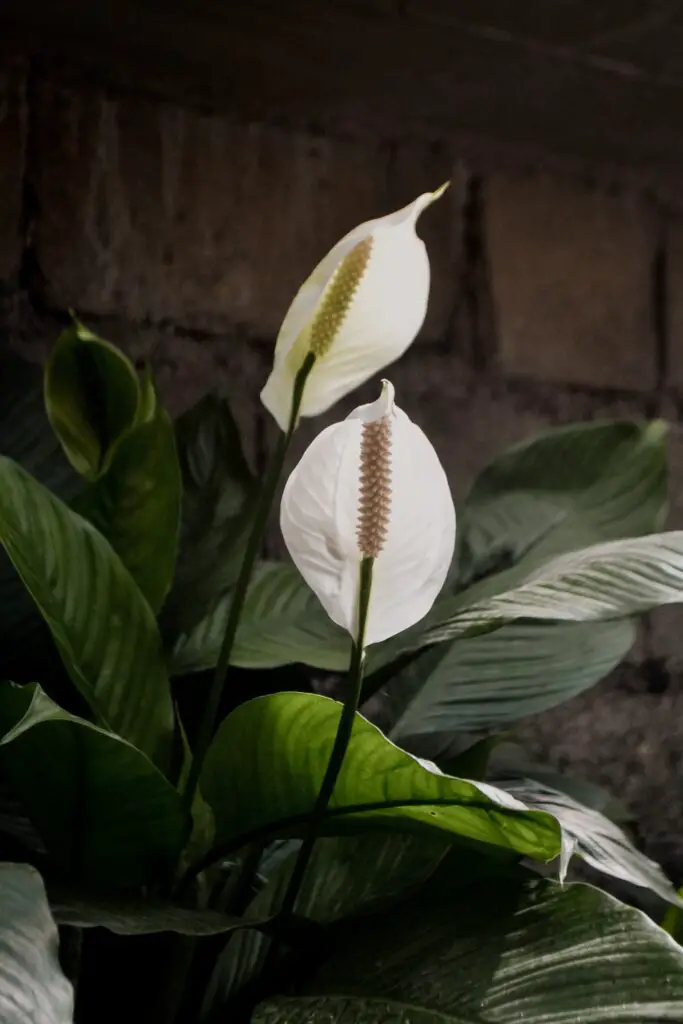Download: Peace Lily Water Requirements: How Much Water Does A Peace Lily Need?
Table of Contents
Peace lilies are one of the most popular houseplants, and for good reason. They are easy to care for, beautiful to look at, and can purify the air in your home. But how much water does a peace lily need, and how can you tell if you’re overwatering or underwatering your plant?
Related: Learn About The Peace Lily Flower Stages
How Much Water Does a Peace Lily Need?
A general rule of thumb is to water your peace lily once a week, or when the top inch of the soil feels dry to the touch.
However, the amount of water a peace lily needs depends on several factors, such as the size of the plant, the type of pot and soil, the temperature and humidity, and the light exposure. Peace lilies prefer moist but not soggy soil, so make sure to drain any excess water from the saucer after watering.
Peace lilies are very forgiving plants, and they will let you know when they need water by drooping their leaves. This is a sign of mild dehydration, and it can be easily fixed by giving your plant a thorough watering.
But don’t wait until your peace lily wilts before watering it, as this can stress the plant and cause it to lose its flowers and buds. It’s better to water your peace lily regularly, but moderately, to keep it healthy and happy.
How to Water a Peace Lily

There are different methods to water a peace lily, but the most common one is to use a watering can or a hose to water the plant from the top, until the water runs out of the drainage holes. This ensures that the soil is evenly moistened, and that any salts or minerals that may have accumulated in the soil are flushed out.
However, you should avoid getting water on the leaves and flowers, as this can cause fungal diseases or brown spots.
Another method to water a peace lily is to use the bottom watering technique, which involves placing the pot in a tray or a sink filled with water, and letting the plant absorb the water through the drainage holes. This method can prevent overwatering, as the plant will only take up as much water as it needs.
However, you should not leave your peace lily in standing water for too long, as this can cause root rot or fungal infections. You should also make sure to change the water frequently, to prevent the growth of algae or bacteria.
Pro Tip: When watering your peace lily, use tap water that has been left to stand for a day or two, especially if you have hard water. This allows time for fluoride and other potentially harmful substances to evaporate, making the water safer for your plant.
How to Tell If Your Peace Lily is Overwatered or Underwatered
While peace lilies are resilient plants, they can suffer from overwatering or underwatering, which can affect their health and appearance. There are some signs to look out for and ways to fix them if you do mess up.
Overwatering
If your peace lily is overwatered, you may notice that the leaves are yellowing, wilting, or turning brown at the edges. The soil may also feel wet or muddy, and you may see fungus gnats or mold on the surface. Overwatering can cause root rot, which can kill your plant if left untreated.
To save your peace lily, you should stop watering it until the soil dries out, and repot it in fresh soil if the roots are damaged. You should also check the drainage of your pot, and make sure it has enough holes to allow excess water to escape.
Underwatering
If your peace lily is underwatered, you may notice that the leaves are drooping, curling, or turning brown at the tips. The soil may also feel dry or crumbly, and you may see dust or cobwebs on the plant. Underwatering can cause dehydration, which can reduce the growth and flowering of your plant.
To revive your peace lily, you should water it thoroughly, and mist the leaves to increase the humidity. This can be particularly beneficial in dry indoor environments. You should also move your plant to a cooler and shadier spot, and avoid exposing it to direct sunlight or drafts.
Other Factors To Consider When Caring For Peace Lilies
- Light: Peace lilies prefer bright indirect light, but they can tolerate low light conditions.
- Temperature: Peace lilies like warm and consistent temperatures.
- Humidity: Peace lilies love high humidity.
- Fertilizing: Peace lilies do not need a lot of fertilizer, but they can benefit from a balanced liquid fertilizer once a month during the spring and summer.
- Pruning: Peace lilies do not need much pruning, but you can remove any dead, damaged, or diseased leaves and flowers to keep your plant tidy and healthy.
- Repotting: Peace lilies do not mind being root-bound, but they may need to be repotted every two to three years, or when they outgrow their pot.
Also Read: Learn How to Take Care of a Peace Lily
Conclusion: Peace Lily Watering Requirements

Peace lilies are wonderful plants that can add beauty and freshness to your home. They are easy to care for, as long as you water them properly and provide them with the right conditions. By following the tips in this guide, you can ensure that your peace lily will thrive and bloom for a long time.
If you have any questions or comments, feel free to leave them below. We would love to hear from you!

